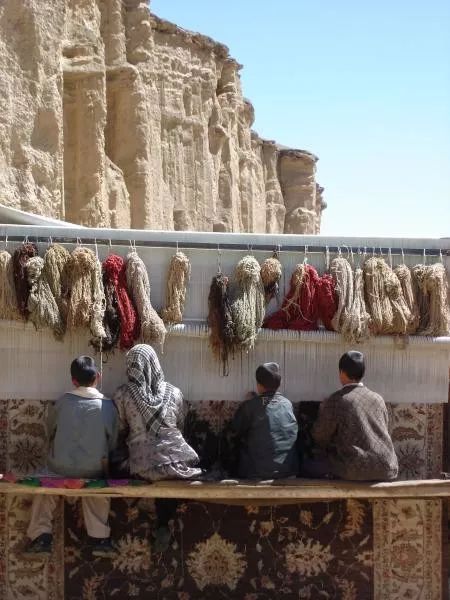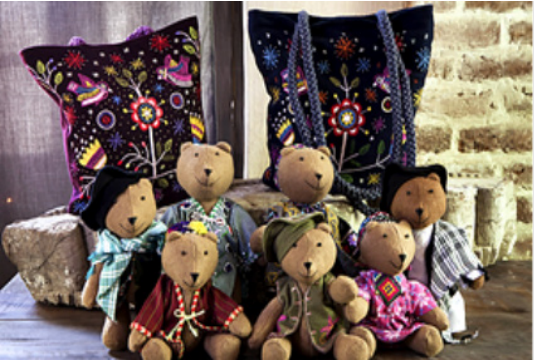Bamiyan, the largest city in central Afghanistan, has a long history and is a major city on the Silk Road. In 2003, Bamiyan was recognized as a UNESCO World Heritage Site for its many historical sites and the "Buddhas of Bamiyan ". In addition, Bamiyan has ancient carpet weaving, embroidery, carving and other traditional folk arts, and its exquisite carpets, clothing, weaving and other crafts are very popular all around the world.
Afghanistan is one of the poorest countries in the world, and decades of war have left the country's economy backward and chaotic, with about 80% of the population living in rural areas. Its economy dependents on agriculture and livestock, which are estimated to account for 53% of GDP. The same is true of Bamiyan, where the number of rural poor is enormous, and even though equality between men and women is added in the law, the idea of male dominance is deeply rooted, and women's social status is still low. In recent years, in the process of women's struggle for social equality, Bamiyan's traditional hand-weaving and embroidery skills have provided an important way for women to become independent, fight for their rights and improve their social status. With the help of the government and international organizations, a large number of women have devoted their energy to handicraft industry, such as carpets, clothing and handicrafts, and many outstanding female
entrepreneurs have emerged who have opened factories, expanded production and employed local women, not only providing employment opportunities for women, but also promoting the economic development and social progress of the city. In 2015, Bamiyan was awarded the "City of Folk Arts and Crafts" by UNESCO as a member of the Creative Cities Network.
1. Handicraft Industry Creates a Large Number of Job Opportunities
Bamiyan's economy was backward, with the number of uneducated women accounting for a large proportion of the population. Women's employment was the biggest challenge in urban development. In Afghanistan, weaving is a must-learn skill for all girls in their growth, and girls are generally taught carpet weaving and embroidery by their mothers at the age of seven. However, in Bamiyan, this handicraft has become the most important source of income for women.
The Silkroad Bamiyan handicrafts was founded in 2010 by a commercial organization, and this project involves various hand-embroidered items such as cushion covers, bedspreads, handbags, shirts and jackets, etc. These hand-made productions are very time-consuming and labor-intensive, as the braided ropes are up to 15-20 meters long, and the weaving work can only be done outdoors, so the production can only be carried out in the period between spring to autumn in a year. However, the complex and handmade productions require the participation of a large number of skilled personnel, which provides a wealth of employment opportunities for women in and around the region.

Handicraftsman in BamiyanIn addition, some women's workshops have developed to enterprises. Relying on their own skills and wisdom, with the help of the relevant departments, they carry out business activities related to handicraft, such as traditional clothing, carpets, handicrafts and weaving, to create employment opportunities for women. Masoma Alizada, president of the Bamiyan Association of Women Entrepreneurs, was the first female entrepreneur to set up a clothing factory in Bamiyan. Started by sewing clothes on her own and accepting orders from the community, she is now an owner of 25 stores and employs many women employees in embroidery and clothes production. Exquisite clothing and exquisitehand-made crafts made her business more and more popular, and she began to participate in handicrafts exhibitions across the country, and even spread local excellent hand-woven art abroad.
2. Handicraft Revival Drives the Progress of Creative Industry
From the point of view of the inheritance and innovation of handicrafts, in order to meet different needs of the market, women need to constantly design new pictures, patterns, decorations in the weaving process, and apply the traditional skills to a wider range of fields. The Bamiyan Peace Bear, for example, is a doll bear designed referring to traditional culture. The Bear wears a variety of traditional Afghan costumes, each of which is sewed by hand, from sewing the bear body to making clothing, hat and accessories. Continuous innovation has breathed new life into traditional skills and used the power of business to spread local excellence to the whole world.

Bamiyan Peace Bear
•The revival of handicrafts has led to the progress of Bamiyan's entire creative industry, and the Buddha of Bamiyan and many historical sites drive the development of the local tourism industry; national and international sports events, such as Tour-de-Bamiyan Cycling competition, Afghan Ski Challenge, etc., have reshaped Bamiyan's city image; and the newly established Bamiyan Cultural Centre has worked to promote culture and creativity as a tool for peace and economic development and created an open society free of conflict.
•In tourism, cultural heritage is the main resource for the development of the tourism industry in Bamiyan, and Bamiyan has continuously strengthened the protection of heritage resources to attract tourists to increase revenue for the tourism industry. In the early days, cultural heritages in Bamiyan were badly damaged. A large number of Buddha statues were blown up by the Taliban, and the Cultural Landscape and Archaeological Remains of the Bamiyan Valley was listed in the List of World Heritage in Danger (LWHD). With the help of numerous international organizations, Bamiyan has made great progress in the protection of its heritage, and has solved the problems of housing, commercial development, illegal excavation of cultural heritage, and improper use of heritage sites for military training through the improvement of transport facilities. In 2015, Bamiyan was identified as the Cultural Capital of the South Asian Association for Regional Cooperation (SAARC). And in 2018, Bamiyan completed the Strategic Master Plan on Heritage Protection and organized a heritage management workshop to fully involve local communities in heritage management.
Today, Buddha of Bamiyan, traditional crafts such as carpets and embroidery become local cultural symbols, and the city is working towards becoming a cultural and creative centre in Afghanistan.
3. Multi-party Assistance from National and International Organizations
As an extremely poor country, Afghanistan's socio-economic progress depend on the assistance of non-governmental organizations and international organizations. Bamiyan's handicraft industry can't be developed without the support of various organizations.
The Afghanistan Rural Enterprise Development Programme (AREDP) has played a significant role in addressing the employment of rural women. AREDP was founded in 2010 by the Ministry of Rural Rehabilitation and Development (MRRD), and aims to promote private sector development in rural Afghanistan through market-oriented rural development mechanisms, rather than by providing dependency assistance. It encourages individuals to set up micro-enterprises, such as clothing stores, shops, beauty salons, machinery workshops, etc., and provides professional skills training for micro-enterprises in marketing, business planning, publicity and sales, business promotion, etc. In Bamiyan province, AREDP's work is concentrated the Bamiyan City, Yakawlang, Saighan and Punjab. It covers 299 small and medium-sized enterprises and 1,033 savings groups, creating jobs for more than 12,500 people.
In addition to AREDP, various national and international organizations have provided important assistance to Bamiyan with funding. The Microfinance Investment Support Facility for Afghanistan (MISFA) is one of the most important organizations to provide financial assistance to various locations. Upwards, it accepted financial support from the International Development Association (IDA) and the Afghanistan Reconstruction Trust Fund (ARTF), and in 2013, IDA provided $50 million to the financing access project, which further supports MISFA as a catalyst for innovation to play a greater role in increasing access to and use of low-end financial services in the market. Downwards, MISFA provides financial support to micro- lenders around the country, such as OXUS, which provides loans to individuals. Up tonow, it has provided a total of 60 million Afghani loans to about 800 customers in Bamiyan.